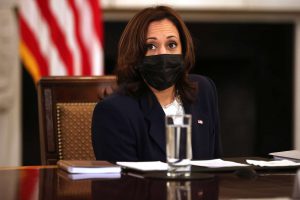APRIL 10, 2021

WASHINGTON, D.C. — In the two-and-a-half weeks since President Joe Biden announced he was tasking Vice President Kamala Harris with leading diplomatic efforts to stem the flow of migrants at the Southern border, the White House has found themselves having to clarify the shape of her role on a near-daily basis.
White House press secretary Jen Psaki has fielded frequent questions on whether Harris’s role includes addressing the current situation on the southern border, while aides to the vice president have quickly shot down suggestions that Harris is focused on anything other than tackling the root causes of migration in Mexico and the “Northern Triangle” countries of Guatemala, El Salvador, and Honduras.
“The Northern Triangle, which I’m sure you’re aware of,” Psaki said Wednesday, “is not the same as the border.”
The confusion clouding Harris’s first big policy assignment underscores the challenges Harris faces as she seeks to define her role inside the Biden White House. It also raises questions as to why the White House did not do more at the outset to clearly establish and communicate the shape of her new policy role.
Since the announcement, aides say Harris has been focused on behind-the-scenes work, reading up on the issues and attending meetings with experts. She has held calls with Guatemalan President Alejandro Giammattei and Mexican President Andrés Manuel López Obrador to discuss migration and has discussed planning a trip to the region, something that aides say she hopes to do soon.
But publicly, her focus has appeared to be elsewhere.
On Monday, Harris visited Oakland, California, to highlight the administration’s new American Jobs Plan. She made another trip to Chicago on Tuesday where she toured a vaccination site. She joined Biden Wednesday for a speech about the jobs plan, spoke about the administration’s steps to combat gun violence on Thursday and attended an economic briefing in the Oval Office on Friday.
Harris did not hold any public events this past week related to migration, and declined to take questions from the reporters traveling with her on her trips outside of Washington.
“This is a priority for her. But it’s also a priority for her to get the jobs plan passed and it’s a priority for her to talk to people about getting vaccinated,” a White House official said. “You can do many things at once.”
When asked in an interview Wednesday with CNBC’s Shepard Smith about when the public could expect to hear from the vice president on migration issues, Psaki said only that she expected that “people will hear from her soon.”
White House aides have expressed some frustration with the situation, saying that reporters were too willing to conflate the root causes of migration with the situation at the border, leading to initial confusion when Harris’s role was first announced. Harris’s role, aides point out, was advertised as a diplomatic mission from the start.
“I actually think that members of the media deserve to have an understanding of what her exact role was,” Psaki said, when asked why the White House felt a need to clarify Harris’s assignment on numerous occasions.
Still, the White House’s messaging has at times added to the confusion.
In a statement Friday announcing that Roberta Jacobson, Biden’s border czar who has played a key role in the Northern Triangle, would be stepping down, National Security Advisor Jake Sullivan said the vice president would continue “overseeing a whole-of-government approach,” appearing to contradict the narrow scope of her role that officials had been insisting on all week.
A senior administration official later said that the vice president’s role was not expanding in any way, and that Homeland Security Secretary Alejandro Mayorkas and Health and Human Services Secretary Xavier Becerra would continue to spearhead the administration’s response to the border.
Some White House officials have also argued that part of the confusion around Harris’s role is rooted in the challenge of explaining to the American public the various reasons why people are seeking asylum — ranging from climate disasters, to violence and poverty — especially after President Donald Trump spent his time in office demonizing migrants arriving at the Southern border.
But Republicans have been quick to tie Harris directly to events on the border. Republican National Committee spokesperson Keith Schipper has described Harris as the “manager of the Biden Border Crisis,” while RNC chair Ronna McDaniel wrote in an op-ed: “Where’s Kamala? Biden’s border point person can’t be bothered to show up.”
Some Democrats worry that the assignment could be politically perilous for Harris, especially as she considers a potential second run for president, but giving a more polarizing task to the vice president is not unusual. Biden was handed a similar role when he was vice president ahead of the 2014 midterms, which saw immigration become a key issue after a similar border surge.
Biden continued to work on the issue through the end of his term, making regular phone calls to leaders in the region and visiting the area on multiple trips.
“I spend so much time in matters relating to this area, my constituents are beginning to think that maybe I should run for office here,” Biden joked on a 2016 trip to Guatemala.
As to when Harris will make her first trip to the Northern Triangle, a White House official said that their team was working on planning the journey, but added: “We are also being mindful that we just announced the American Jobs Plan and were doing multiple things at one time.”










































































































